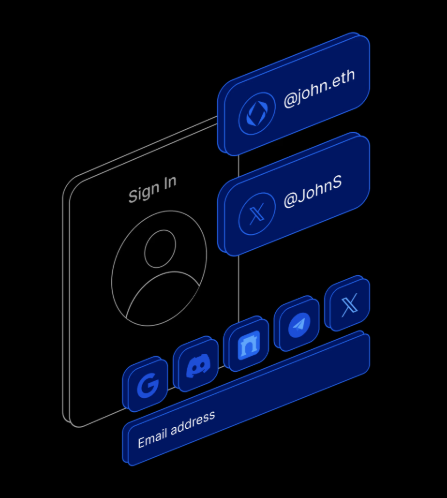As the digital economy continues to expand, the need for secure, user-friendly, and efficient digital asset management solutions is becoming more important than ever. Two emerging technologies, embedded wallets and Wallet-as-a-Service (WaaS), are playing a pivotal role in transforming the way we manage and interact with digital currencies. These solutions not only simplify access to blockchain and Web3 ecosystems but also offer unparalleled scalability, security, and convenience. This article will dive into how embedded wallets and WaaS are shaping the future of digital asset management, their benefits, and their real-world applications.
What Are Embedded Wallets?
Embedded wallets are digital wallets integrated directly into platforms, services, or applications. Unlike traditional wallets that require users to download and manage separate software or hardware, embedded wallets provide a seamless experience by being built into existing systems. This integration allows users to access digital currencies within the platform itself, eliminating the need to switch between different apps or services.
Key Features of Embedded Wallets
- Seamless Integration: Embedded wallets are directly integrated into platforms like e-commerce sites, gaming applications, or decentralized finance (DeFi) protocols, streamlining user interaction.
- User-Friendly: These wallets are designed to be intuitive, making them accessible even to those with minimal technical knowledge.
- Enhanced Security: Many embedded wallets come with advanced security measures, such as encryption, multi-factor authentication, and private key management, ensuring the safety of digital assets.
- Customization: Platforms can customize embedded wallets to match their branding and operational requirements, providing a tailored user experience.
Use Cases for Embedded Wallets
- E-commerce: Online retailers can integrate embedded wallets to allow customers to make cryptocurrency payments directly on their websites, eliminating the need for external wallet apps.
- Gaming: Gamers can store and use in-game assets, NFTs, or virtual currencies within gaming platforms, facilitating seamless transactions.
- DeFi Platforms: Embedded wallets allow users to engage with decentralized protocols, including staking, trading, and investing, without the need for external wallets.
What is Wallet-as-a-Service (WaaS)?
Wallet-as-a-Service (WaaS) is a solution that enables businesses to integrate wallet functionalities into their platforms without the need to build a wallet infrastructure from scratch. WaaS provides a plug-and-play service, offering businesses a scalable and cost-effective way to offer wallet services to their users.
How WaaS Works
WaaS providers offer APIs and SDKs, which businesses can use to integrate wallet functionality into their platforms. These services handle the technical complexities, including wallet creation, security, and compliance, allowing businesses to focus on their core services without worrying about the intricacies of wallet management.
Core Features of WaaS
- Scalability: WaaS solutions are designed to accommodate the needs of businesses of all sizes, from startups to large enterprises.
- Regulatory Compliance: WaaS providers ensure that the wallets comply with relevant regulations, such as Know Your Customer (KYC) and Anti-Money Laundering (AML) requirements.
- Multi-Currency Support: WaaS solutions typically support various cryptocurrencies, stablecoins, and tokens, providing businesses with flexibility.
- Interoperability: Wallets created with WaaS can interact with different blockchains and protocols, expanding the range of services that businesses can offer.
The Intersection of Embedded Wallets and WaaS
When combined, embedded wallets and WaaS offer a powerful solution for businesses and users alike. Embedded wallets focus on providing a smooth, user-friendly experience, while WaaS provides the infrastructure that powers these wallets, ensuring security, scalability, and compliance. Together, these technologies create a seamless and efficient digital asset management solution.
Benefits of Combining Embedded Wallets with WaaS
- Faster Deployment: Businesses can quickly launch wallet services without needing extensive development resources.
- Improved User Retention: By integrating wallets into their platforms, businesses can keep users within their ecosystem, making it easier for them to manage assets and complete transactions.
- Cost Efficiency: WaaS significantly reduces the costs associated with building and maintaining wallet infrastructure.
- Customizable Solutions: Businesses can design embedded wallets that align with their branding and user needs, providing a tailored experience.
Real-World Applications
- Financial Services: Banks and fintech companies are adopting WaaS to offer secure digital wallets for managing cryptocurrencies. Embedded wallets help streamline customer interactions, allowing services like peer-to-peer transfers, crypto lending, and staking within the banking app.
- E-commerce: Retailers are integrating wallets to accept cryptocurrencies as payment, expanding their customer base. WaaS ensures these transactions are secure, compliant, and efficient.
- Gaming and the Metaverse: Gaming platforms and virtual worlds are utilizing embedded wallets to let users store and trade in-game assets, NFTs, and other virtual items. WaaS provides the secure and scalable infrastructure needed to support these activities.
- Decentralized Applications (dApps): DeFi platforms are leveraging WaaS-powered embedded wallets to enhance accessibility, allowing users to participate in governance, trade, and invest without the need for external wallets.
Advantages of Embedded Wallets and WaaS
For Businesses:
- Increased User Engagement: Integrated wallets create a seamless experience, encouraging more frequent use and interaction with the platform.
- Improved Operational Efficiency: WaaS offloads the complexities of wallet management, allowing businesses to focus on their core operations.
- Brand Differentiation: Offering embedded wallets can position a company as a technological innovator, attracting tech-savvy users.
For Users:
- Simplified Experience: Embedded wallets eliminate the need for multiple apps, allowing users to manage their assets and conduct transactions within one platform.
- Enhanced Trust: Built-in wallets provide users with greater security and reliability when managing their digital assets.
- Broader Accessibility: WaaS-powered wallets support a variety of currencies and blockchains, giving users more financial options.
The Future of Digital Asset Management
As blockchain technology continues to evolve, embedded wallets and WaaS are poised to play a key role in digital asset management. These solutions are helping businesses drive financial inclusion, simplify cross-border transactions, and support the growth of Web3 ecosystems.
Conclusion
Embedded wallets and Wallet-as-a-Service are transforming digital asset management by offering secure, scalable, and user-friendly solutions for businesses and consumers alike. These technologies bridge the gap between traditional finance and decentralized systems, providing new opportunities for both users and businesses in the digital economy. As they continue to grow and mature, they will become increasingly integral to the future of financial services, enhancing the accessibility and usability of digital assets across various industries.












